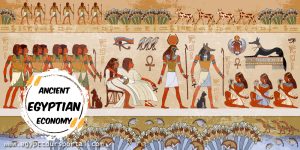
Features of the Egyptian Economy
Prof. Dr Moustafa El-Abdallah Al Kafry
Features of the Egyptian Economy
Prof. Dr Moustafa El-Abdallah Al Kafry
Introduction:
The security and political turmoil witnessed in Egypt since 2011 has affected the economic conditions of the state, as the rate of economic growth has decreased, the unemployment rate has risen, the size of the deficit in the public budget has increased, the size of the public debt has increased, and Egypt’s reserves of foreign exchange have declined in light of the stability of the exchange rate for a long time, as well as the rate of inflation has risen. (Since 2014, the country has embarked on knowledge-based economic growth, moving towards digital transformation, increasing the resilience and competitiveness of the economy, increasing employment rates and decent work opportunities, improving the business environment and promoting a culture of entrepreneurship, as well as achieving financial inclusion and integrating the environmental and social dimension into economic development.)[1]
Egypt achieved a low economic growth rate during 2013/2014 by 2.9% as a result of internal events and conditions of instability witnessed in Egypt since January 2011, the stability of security and political conditions reflected on the driving force of economic growth and gradually increased until it reached 5.56% in 2018/2019. Due to the impact of various productive sectors on the Corona pandemic crisis, the economic growth rate in 2019/2020 decreased to 3.57% in 2019/2020. This prompted international institutions to praise the performance of the Egyptian economy and its resilience in the face of the pandemic, amid the decline in growth rates in the face of the pandemic. Different countries are recorded for negative rates. The International Monetary Fund (IMF) has predicted that the Egyptian economy will grow by 2.8 percent in 2020/2021, and then rise to 5.2 percent in 2021/2022.[2]
The study deals with the stages of development of the Egyptian economy since the fifties of the twentieth century, the Egyptian economy has gone through a number of stages since the end of the royal era and the transition to the republican system following the Free Officers Revolution in 1952, and the adoption of the strategy of substitution of imports and the independence of the Egyptian economy from political and colonial pressures through the adoption of socialist orientations, where nationalization decisions and agrarian reform laws were issued, and dependence on the public sector, Central planning, then the stage of political and social considerations that accompanied the implementation of the strategy of replacing imports and led to the decline in the performance of the public sector and the faltering of central planning, and then the cracking of that strategy and the repercussions of the transition to a market economy. In the third phase, which began in the wake of the October 1973 war for the most important policies of economic openness, where the orientation to the market economy, and the adoption of the strategy of orientation to export, and also discusses the most important challenges facing the Egyptian economy, in light of external and internal pressures calling for economic reform and privatization, and finally the study deals with the importance of concluding economic agreements with different countries and their impact on The Egyptian economy.[3]
[1] – Mahmoud Al , OmarJ, Successes and achievements. Study reveals what the Egyptian economy achieved during the period from 2014 to 2021, the seventh day, Monday, October 11, 2021.
[2] – Features of the Egyptian economy during Period، (2014-2021) A study for the Egyptian Center for Thought and Studies، The seventh day, Monday, October 11, 2021.
[3] – Dr. Khairy Abu Invitations Fergani, Features of the development of the Egyptian economy in light of political and economic transformations.
Link to download the research in PDF format: Features of the Egyptian Economy
Features of the Egyptian Economy
Prof. Dr. Moustafa El-Abdallah Al Kafry
Contents
I – Stages of Development in Egypt: 5
1 – Redistribution of income and wealth (1952 – 1960): 5
2 – Comprehensive planning (1960-1966): 5
3 – War economy (1967 – 1973): 6
4 – Economic openness (1974-198): 6
5 – Return of Comprehensive Planning (1982-1990): 7
II – Economic reform in Egypt (1991-1997): 8
1- Reform of the Egyptian tax system: 9
2 – Development of customs tariffs: 10
3- Reform of the Egyptian banking system: 10
4- Privatization policies in Egypt: 11
III – Egyptian Foreign Trade and Export Promotion. 12
IV – The Social Fund for Development in Egypt: 13
V – Challenges facing the Egyptian economy: 14
– The real economic challenge facing Egypt: 14
VI – Economic Development Plan: 15
1 – The structure of Egyptian industrial production: 16
2 – The problem of unemployment: 16
VII – The International Monetary Fundand the Economic Reform Program in Egypt: 17
VIII – Improving the standard of living of the citizen: 19
1 – Communication and Information Structure: 19
2 – Modern economic management: 20
IX – Inflation rate and liberalization of the Egyptian pound: 20
2 – Floating the Egyptian Pound: 22
X – Improving the investment environment: 24
1- General budget and size of public debt: 25
